Author: Dr. Michael Chase

Source of the figure above: http://www.bom.gov.au/climate/change/#tabs=Tracker&tracker=timeseries
Summary
There is considerable climate distortion in the ACORN-SAT version of surface air temperatures of Australia from 1910 to present, with most of the distortion in the first half of the 20th century. The main problem lies in the assumption made that all non-climatic influences, detected via anomalous step changes in temperature, do not vary with time. Many non-climatic influences, such as urban heating and screen degradation, do vary with time, so whilst the ACORN-SAT correction process does a good job for some years before step changes occur, it over-corrects at earlier times, often giving an invalid cooling of the early decades of the 20th century.
This problem with ACORN-SAT is only at the final stage of processing, when corrections are applied. The step change information itself is highly valuable and it should be possible to produce a more accurate version of the temperature history of Australia, if possible by following how non-climatic influences vary with time in the data, or by modelling.
Introduction
Reconstructing the actual surface temperatures of Australia back to 1910 is a difficult job which has to contend with several non-climatic influences on what is sometimes incomplete, erroneous and poorly documented temperature data. The ACORN-SAT reconstruction detects non-climatic influences when they change, either sudden onsets or removals. Data from neighbouring stations is used to detect and estimate the size of sudden and persistent changes in relative temperature, deemed to be non-climatic in origin. The final stage of processing is to correct the temperature data so as to reveal the true background climate variations.
The following figure illustrates where things go wrong for any time-varying influence, shown as the red curve:
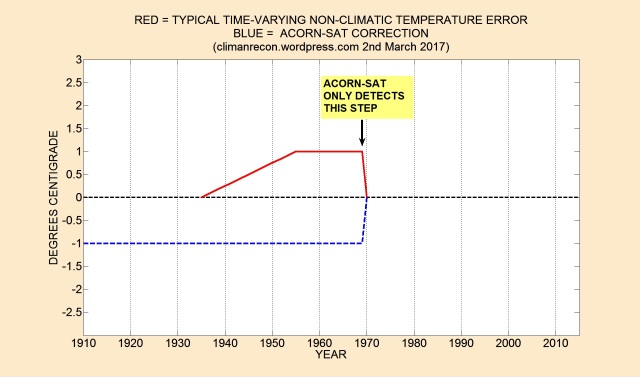
The red curve in the figure above applies to common non-climatic influences such as urban growth around weather stations located in towns, or the gradual degradation of the thermometer screen. When a weather station moves out of town, or to a better location within the town, or a screen is replaced, the temperatures recorded suddenly drop (relative to those of neighbours), an event detected by the ACORN-SAT algorithms. The erroneous assumption (shown as the blue curve) is then made that the non-climatic influence is constant in time, resulting in over-correction in the entire period leading up to the full effect of the influence.
Examples
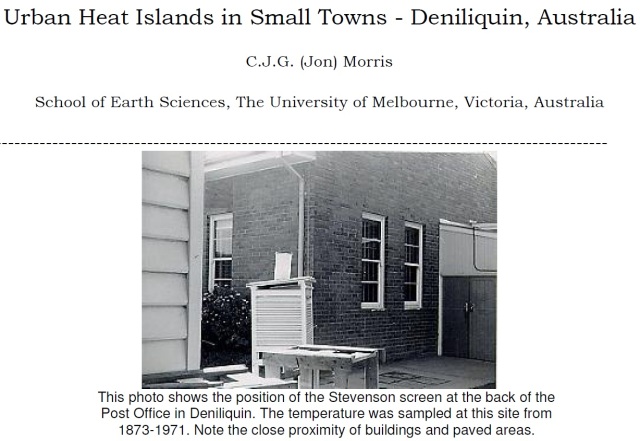
Source of the picture above: http://www.hashemifamily.com/Kevan/Climate/Heat_Island.pdf
When the weather station at Deniliquin moved to a better location in the town in 1971, the minimum temperatures recorded fell by around 1 degree C on average, probably mostly due to the removal of the heating effect of the buildings and paving stones. ACORN-SAT assumes that the urban heating in 1971 was constant all the way back to 1910.
Another example is given in the ACORN-SAT documentation itself, for a site move in Inverell in 1967:
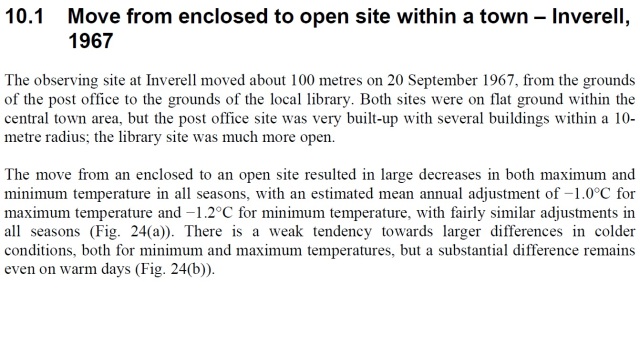
Source of the extract above: http://cawcr.gov.au/technical-reports/CTR_049.pdf
Again, ACORN-SAT assumes that the urban heating of the very built-up post office site applied all the way back to 1910, though in this case there were also earlier step changes. Integrating the step changes of time varying influences does not in general get you anywhere near the right answer for early decades.
There are many examples in the ACORN-SAT station adjustment summary of step changes due to equipment replacement, many likely to be due to a recent degradation being removed by the provision of new equipment. ACORN-SAT assumes that the degraded equipment was in place all the way back to 1910.
Previous Commentary
I must apologise at this stage for being unfamiliar with most of the literature on temperature homogenisation, so am probably not giving due credit to previous authors. The following two examples are relevant, firstly from Hansen et al, 2001:
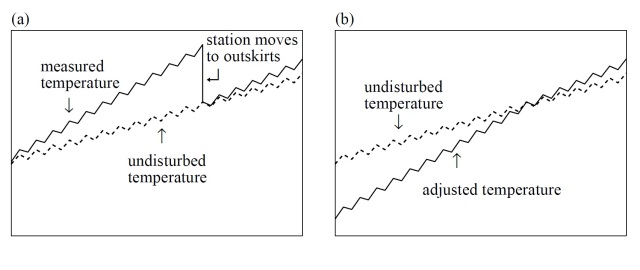
Source of the figure above: https://pubs.giss.nasa.gov/abs/ha02300a.html
The figure above shows a time-varying urban heating being correctly removed around the time of a station move, but being over-corrected at earlier times. There are several examples in ACORN-SAT of town data being merged with that from an airport, with an unknown amount of historical urban heating being turned into erroneous cooling of early data.
The second example is from Stockwell and Stewart (2012), correctly identifying a major reason why the pre-cursor to ACORN-SAT gives more apparent warming than is found in raw data:
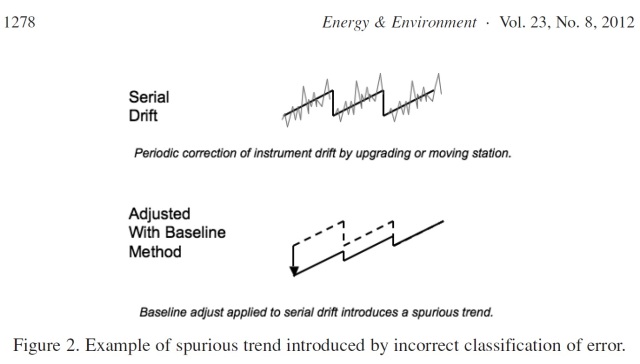
Source of the figure above: http://citeseerx.ist.psu.edu/viewdoc/download?doi=10.1.1.362.9661&rep=rep1&type=pdf
The Way Forward
ACORN-SAT only falls at the final hurdle, the temperature step changes that it identifies can be used to redeem it. Here is an example of a validation of one of its discontinuities:
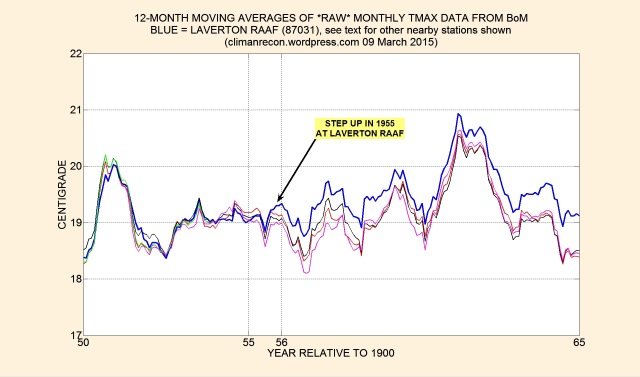
The figure above shows an anomalous step-up in average maximum temperatures at Laverton RAAF (blue curve), as well as possible indications of anomalous warming in the 1960s relative to neighbours: Melbourne Regional (-0.8C), Essendon Airport (-0.1C), Black Rock, and Tooradin.
One way to deal with urban warming, most of which is historical rather than current, is to construct composite temperature records, in the example above following Laverton up to its step change, then jumping to a suitably scaled average of its more rural neighbours.
For large temperature step changes, such as those shown above for Deniliquin and Inverell, it should be possible to follow, and thereby properly correct, the time variation of the urban warming down to a certain minimum level. For smaller temperature changes, many of which occur in regions without reliable near neighbours, modelling of the urban heating can be used, guided by any available documentation of the station history.
This post ends here, examples will be shown in later articles of the size of ACORN-SAT errors, but the focus will shift to the question of what is the right answer for Australian temperature histories.

Excellent explanation of the problem! I look forward to future posts.
Ken Stewart
LikeLike
The slope vs step correction problem you have identified makes perfect sense. You are obviously correct and it would be responsible for much of the post adjustment warming. However you say “ACORN-SAT only falls at the final hurdle, the temperature step changes that it identifies can be used to redeem it.” Not so sure that is correct. It assumes that both sites produce linear un-distorted output of actual air temperature at the healthy points in time before the gradual deterioration. Sadly these Stevenson screens produce multiple forms of non-linearity and distortion in both time and temperature domain when in good condition. So do thermometers suffer hysteresis. Also different screen sise and types have been used. I doubt two screens made from wood that came from different parts of the same tree would produce the same temperature because of the variable thermal inertia of wood let alone few sites being perfect around the screens. This heat storage of wood exchanged with the air via the louvres on the Stevenson screen sides would also vary with paint types. None the less what you are seeing is real and you should loudly proclaim it.
LikeLike
Thanks for those comments, any effective calibration error that is constant in time (in monthly averages) is not really a problem when determining trends. The station history summary in the thesis of Simon Torok mentions several screens being “large” or the “wrong type”, I’ll look out for any temperature shifts when the screens were changed.
LikeLike
Hi ClimateRecon,
It is an interesting and plausible hypothesis that possibly, at least in theory, the compensation for Urban Heat effect could be an issue due to the use of step changes instead of more graduated corrections.
However In practice it probably has little to no significance. The Deniliquin example well illustrates this.
Looking at the discrepancy between the Raw and Acorn data from 1910 until the present, the bureau has published that there were two station movements that impacted Tmin firstly in August 1971 and then in June 1997. The former was the more significant in that this adjustment lowered prior temperatures by 1C while the latter was less significant with an adjustment of 0.5 C see Chart 1 of http://www.bom.gov.au/climate/change/acorn-sat/documents/station-adjustment-summary-Deniliquin.pdf .
It is well know that the UHI has a logarithmic dependence on population see https://www.google.com.au/webhp?sourceid=chrome-instant&ion=1&espv=2&ie=UTF-8#q=urban+heat+island+logarithmic+population&* .
Only an exponential growth in the population would lead to a linear increase in temperatures. It would be extremely unlikely to the point of absurdity for this increase to have occurred at Deniliquin since 1910. The population of Deniliquin is currently less than 8000. Rather than increasing exponentially most rural towns have shown stagnant or decreeing populations over extended periods. It appears Deniliquin‘s hay day was in the 1850s to the latter part of the 19th century so it is unlikely that there has been a significant increase in population over an extended period, from 1910 until 1971 when the first adjustment was made. Who knows, but the vast majority of the UH effect would have been likely to have arisen in the early days well before 1910 , when the population was small and the corresponding logarithmic increase in population the most significant.
Additionally the weather station, prior from 1873 until 1971, was close to the Post Office brick wall as shown above. The first post office was built in 1850. I suspect the post office building that Is shown was built, at some later time. If someone wants to follow-up, a PDF history of the post office can be purchased from http://catalogue.nla.gov.au/Record/423406 .
It is more than likely that the wall of the post office may well have been the primary determinant for the UH effect. This wall may have been there well before 1971 and even back to 1910. The effect of this wall would most likely have dominated any other possible local heat effects.
The above reasons are probably why there is no evidence of increasing temperatures during the period 1910-1971 in fact temperatures decreased marginally during this period. This is totally inconsistent with an increasing UH effect during this period, unless it is masking some dramatic decrease, which is not evident elsewhere.
Perhaps you have another example that can provide some or any practical evidence for your hypothesis?
In summary I think it is clear that the approach taken by the BOM in adjusting the Tmin data is appropriate for Deniliquin and is probably appropriate for the vast majority of the Acorn network which are predominantly rural.
I admit that I have indulged some, speculation above, such as with respect to the Post office. However it would take some imaginative assumptions regarding population growth etc. that would dwarf even mine to think the approach advocated above would be a worthwhile improvement to the adjustment of the data.
Finally, thanks ClimateRecon for providing such thought provoking material.
LikeLike
The logarithmic UHI model is probably a good one for “background” heating, but on top of that there will be very local effects such as from walls, sheds and paving stones. Also, there is a threshold of 0.3C used in ACORN-SAT for its step change detections, so encroachment of buildings can happen in stages and not get detected.
There are hints in a data comparison with nearby Echuca that anomalous heating at Deniliquin started in around 1920 at a lot less than the full 1C, and grew from then, but Echuca was also a town site then, so its difficult to draw firm conclusions.
I’m pretty confident that transient thermal degradation will turn out to be a significant source of error in ACORN-SAT, but cannot quantify it at this early stage of the investigation.
LikeLike
Yes there can be local effects as you describe which are probably impossible to quantify. The issue is that the BOM has reduced the temperatures at Deniliquin by 1 degree prior to 1971 by comparison with adjacent sites.
I must emphasize again that the trend is decreasing (not increasing) at a rate of -0;.0025 degrees C per annum from 1910 until 1971. This corresponds to a decrease (not an increase) of 0.16 C over the 61 year interval. In light of this, the model where buildings encroach and generate local heating is nigh on impossible.
If anything the buildings may have progressively shielded the weather station from direct sunlight! This scenario is at least least plausible as it would be consistent with a negative trend .
The Echuca data also shows a negative trend of -0.0051 degrees per annum for the period 1910 to 1971 so I am not sure how this, in any way, supports your case.
Personally I would cut my losses with your attempt to quantify the transient thermal degradation error until you can find a case where it can be used practically. Deniliquin is a very poor choice.
LikeLike
I have no problem with a correction of 1C around 1970, that shift can be seen clearly in the data, but I don’t think that comparing trends answers the question of what the correction should be around 1910. There are a lot of indications in the data I’m looking at that background Tmin in that area was falling in the first half of the 20th century.
LikeLike
Firstly apologies about my preceding comment about the possibility of shading of the weather station by encroaching buildings. That would be more relevant for Tmax. The only plausible way that Tmin would be,affected is via a second order effect i.e. the encroaching buildings (or trees) shielding the wall of the post office.
However my point still stands that the negative trend in Tmin is totally inconsistent with an increasing urban heat effect.
Your last sentence above is very puzzling. Can you elaborate on how a falling ‘background Tmin’ , if this is the case, allows one to estimate Tmin and thereby obtain the correction for 1910?
LikeLike